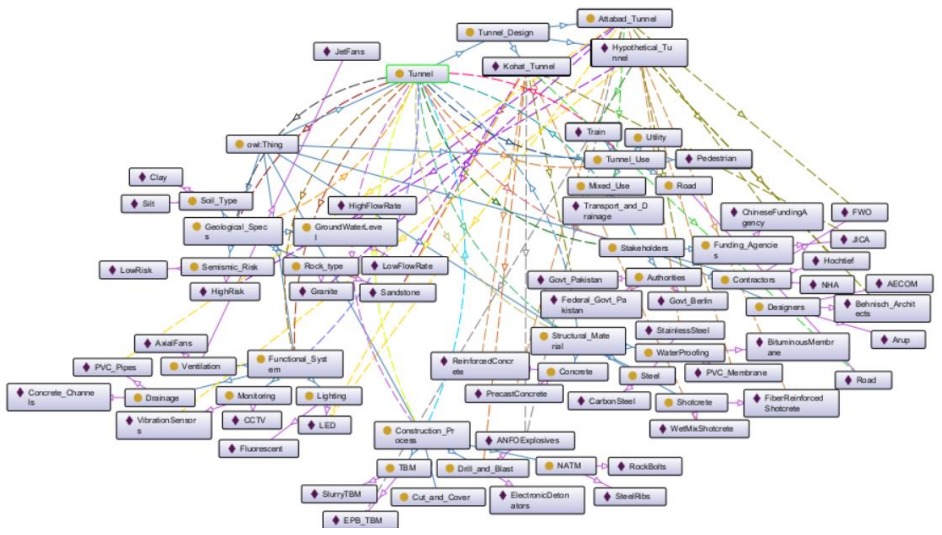Tunnel Number 01
- Ontology
Introduction
Tunnels are important civil engineering systems that help in efficient transportation, utility management and connectivity in challenging terrains. But, designing and managing these systems require complex co ordination and interdependence between stakeholders, materials, functional systems and geological specifications. An ontology provides a structured framework to model these complexities comprehensively. The aim of this ontology is to create a generalized representation of tunnel systems, helping in system design, analysis, and comparison. It’s focus is to facilitate users like engineers, planners, and educators, facilitating tasks such as decision-making and project evaluation. By including real-world examples of the Kohat Tunnel and Attabad Tunnel from Pakistan’s mountainous region, the ontology demonstrates adaptability to specific cases while remaining flexible for future cases.
Purpose of this Ontology
The primary objective of this ontology is to provide a well-structured, reusable framework for modeling tunnel systems. Tunnels are complex engineering structures that require careful planning and analysis, involving diverse components such as geological contexts, structural materials, functional systems, and construction processes (as mentioned earlier).By summarizing these elements within a unified ontology, this framework serves multiple purposes:
Facilitating Decision-Making: It enables engineers and planners to evaluate various tunnel design options based on geological, material, and system requirements.
Enhancing Communication: It provides a shared vocabulary and conceptual framework for various teams working on a project such as designers, geologists, contractors, and other stakeholders.
Educational and Analytical Tool: It serves as a reference for students and researchers studying tunnel design and construction. o It offers a basis for analyzing real-world tunnel systems, as demonstrated by the examples of the Kohat Tunnel and Attabad Tunnels.
Adaptability for Future Projects: It is designed to be extendable, allowing for the inclusion of new materials, systems, and methods. o It supports the modeling of hypothetical tunnels in unique geological or functional scenarios.
By integrating the real-world examples and logical axioms, this ontology bridges theoretical knowledge with practical application hence making it a valuable resource for both academic and professional use.
Scope of this Ontology
This ontology covers a wide range of components and their relationships relevant to the design, construction, and maintenance of tunnel systems. Its broad scope ensures applicability across various use scenarios, from real-world infrastructure projects to academic research. The key areas covered by this ontology include:
Core Components: The ontology models vital elements of tunnel systems, such as, Structural materials, Functional systems, Construction processes and Geological Specifications.
Interconnections and Relationships: The ontology establishes logical relationships between tunnel components, such as hasStructuralMaterial, hasConstructionProcess, and hasGeologicalSpecs.
Flexibility for Varied Scenarios: It caters to both Real-World Projects and Hypothetical Scenarios.
Reusability and Extendibility: The ontology has been designed to extend for new applications such as incorporating emerging materials and technologies. It is a generalized framework hence it can accommodate customized specific projects.
Intended users of this ontology
The ontology caters to a diverse group of users involved in tunnel systems, including: 1. Planning and Design Engineers: o Use the ontology to design tunnels that meet specific operational and environmental requirements.
Researchers: Use the ontology for case studies, theoretical modeling, and simulation.
Funding Agencies: Use the ontology to understand the components and cost of tunnel projects before approving or allocating resources.
Contraction Firms: Use the ontology to optimize materials, methods, and timelines during project execution.
Stakeholders
It has entities involved in the tunnel lifecycle such as Designers, Contractors, Authorities and Funding Agencies. o It has data properties such as organizationName and role. o It has object properties such as hasStakeholder and isStakeholdeOf.
Domain
The domain of this ontology is Tunnel (civil engineering system), which holds the central place in the whole model. o It has general data properties such as tunnelName, location, length, diameter and yearConstructed. o Some of the relationships are hasTunnelUse: Links the tunnel to its primary use (e.g., road, train). hasStructuralMaterial: Associates the tunnel with its structural components.
Onto Graf of Ontology
Engineering Examples
The ontology was tested by modeling 2 real-world tunnels from Pakistan region and 1 hypothetical tunnel from Berlin region.
Kohat Tunnel
Tunnel Use: Road.
Structural Material: Reinforced Concrete, WetMixShotcrete.
Functional System: LED.
Construction Process: Drill and Blast technique ANFOExplosives.
Geological Context: Sandstone, Low Groundwater Presence.
Stakeholder: JICA (Japan International Cooperation Agency), Pakistani Government.
Attabad Tunnel
Tunnel Use: Transportation and Drainage.
Structural Material: PreCast Concrete and PVC membrane.
Functional System: LED, PVC Pipes.
Construction Process: Drill and Blast technique ANFOExplosives.
Geological Context: Granite, High Groundwater Presence.
Stakeholder: Chinese Funding Agency, FWO (Frontier works organization)
Hypothetical Tunnel:
Tunnel Use: Train
Structural Material: Fiber Reinforced Shotcrete and Stainless Steel.
Functional System: Vibration Sensors.
Construction Process: EPB_TBM.
Geological Context: High seismic risk.
Stakeholder: Behnisch_Architects, Hochtief, Govt_Berlin
Conclusion
This ontology provides a structured framework for modeling tunnel systems by addressing design complexity. Its adaptability is demonstrated through real-world examples like Kohat and Attabad Tunnels, as well as hypothetical future applications. Future work could incorporate dynamic simulation tools or cost-benefit analyses to enhance decision-making further.
References
- Krötzsch, M., Vrandecic, D., & Völkel, M. (2006). Semantic MediaWiki. Proceedings of the International Semantic Web Conference (ISWC). Provides foundational principles for structuring ontologies.
- Noy, N. F., & McGuinness, D. L. (2001). Ontology Development 101: A Guide to Creating Your First Ontology. Stanford Knowledge Systems Laboratory. A step-by-step guide to creating ontologies, particularly useful for tools like Protégé.
- Chapman, D. N., Metje, N., & Stark, A. (2017). Introduction to Tunnel Construction (2nd ed.). CRC Press. Covers the full range of tunnel construction areas, including hard-rock and soft-ground conditions.
- Barton, N. (2002). Tunnel Engineering Handbook. Springer. Covers geological aspects and construction methodologies in tunnel engineering.
- Rogers, C. D., & Littlejohn, G. S. (1996). Rock Mechanics for Engineers. Taylor & Francis. Provides insights into the properties of materials like sandstone and granite.
